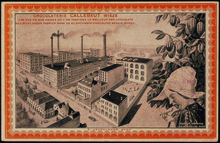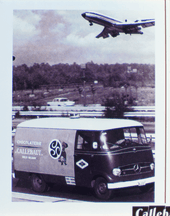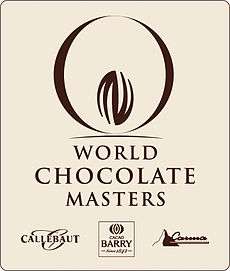Callebaut
 | |
Native name | Callebaut |
|---|---|
| PLC | |
| ISIN | BE0933072291 |
| Industry | Chocolate |
| Predecessor | Chocolaterie Callebaut |
| Founded | 1911 |
| Founder | Octaaf Callebaut |
| Headquarters | Wieze, Belgium |
Area served | Global |
| Products | Couverture chocolate |
| Parent | Barry Callebaut |
| Website | www.callebaut.com |
Callebaut is a Belgian chocolate brand, owned by the Barry Callebaut group.
About
Callebaut is a Belgian couverture chocolate manufacturer. Couverture chocolate is chocolate with a high cocoa butter content used by gourmet and culinary professionals. Many professionals who use Callebaut couverture chocolate use it for its workability and typical taste, which has remained constant over the decades.
The company's core chocolate range is manufactured in Belgium from bean to chocolate according to traditional recipes. Callebaut still applies the whole-bean roasting technique (instead of roasting cocoa kernels), as it did over 100 years ago. This technique allows the preservation of all the flavors and aromatic oils within the cocoa husk and fully releases them in the chocolate. Whole-bean roasting is nowadays often used by artisan, small-batch chocolate makers. Callebaut has preserved this original roasting method.
History

Chocolaterie Callebaut
‘Chocolaterie Callebaut’ was established in 1911[1] by Octaaf Callebaut in the small Belgian village of Wieze. His chocolate company took up the same factory building his grandfather Eugène Callebaut founded as a family-run brewing and milling company called ‘De Ploeg’ in 1850.
Octaaf Callebaut’s chocolate recipes (of which the 811 and 823 recipes are still produced today) quickly took to the liking of numerous chocolatiers, bakers and pastry chefs. As a result Chocolaterie Callebaut PLC was established in 1930. A clear focus towards the professional market took shape and the company from then on dedicated its activities to supplying and servicing chocolatiers, confectioners and bakeries.

Focus on couverture chocolate
After Octaaf Callebaut’s death, his daughter Marie and his nephew Charles Callebaut took over the company in 1945. After World War II, the production of couverture chocolate became the company’s core business, complemented by a limited range of bars and tablets. Callebaut now offered chocolate for artisan chocolatiers around the world and the company’s W2 reference was created.
By 1965 Callebaut couverture chocolates had entered new markets across Europe and overseas, marking the beginning of Callebaut’s global exploration.
in 1988, the Callets see the daylight: these small drop-shaped chocolate pieces were developed to optimize the workability of chocolate. Dosing, melting and tempering work better with smaller drops than with the original big 5kg blocks of chocolate.
In the same year Callebaut established the Callebaut College in Belgium. It is a teaching and training center for artisans and professionals who want to improve their working skills in chocolate and learn about new trends, techniques and recipes. It was the first of the current 13 Callebaut Chocolate Academies, located all over the world.

Sustainable growth
In 1996 Callebaut merged with French chocolate maker Cacao Barry to form the Barry Callebaut group. Both chocolate brands however still remain existent separately under the Barry Callebaut umbrella, with Callebaut as its premium couverture chocolate brand for Belgian Chocolate.
In 2002 Callebaut called the Callebaut Ambassador Club into existence to support the development of new products, packaging, recipes and professional training events. Today, the club counts 55 members worldwide, all of which are renowned chefs, pastry chefs and confectioners with an international reputation. In the same year, Callebaut, together with chocolate brands Carma and Cacao Barry, organized the World Chocolate Masters for the first time. The World Chocolate Masters were (and still are) the only international competition in the world solely dedicated to the art of chocolate. As a result of its tremendous success, the competition instantly grew into a biennial event.
In May 2012 Callebaut was Belgium’s first chocolate brand to shift to sustainably grown cocoa for all its Finest Belgian Chocolate recipes. The launch of Callebaut’s Growing Great Chocolate program was aimed at making cocoa cultivation a sustainable source of income for West African farmers and have a positive impact on farmer livelihoods. [2][3]
Innovations
From its very establishment, Callebaut took on the role of innovator. This list portrays several innovations ascribed to the chocolate company:
- 1925
- Callebaut invents a way to store and transport liquid chocolate from the factory in Wieze right to the customer’s doorstep – quite a revolutionary feat for the time.
- 1988
- With the introduction of the Callets, Callebaut openly chooses sides with the chocolate professionals. While before chocolate was only sold in bigger chunks, the new small chocolate drops are a real breakthrough in the market. Until today, they remain highly popular among professionals, as they make Callebaut’s couvertures much easier to dose, melt and temper.
- 1998
- Callebaut creates the first Origine chocolates (Arriba, Java, Sao Thomé and Grenade) made entirely with cocoa from a single region. The Origine chocolates carry the aromas of flowers, herbs and spices that are typical for the soil where the cocoa is grown, resulting in overwhelming flavors and characteristic subtleties.
- 2005
- With MycryoTM Callebaut creates 100% pure and natural cocoa butter in powder form. Although it makes tempering chocolate easier, MycryoTM is primarily developed for cooking. The odorless vegetable fat creates a thin, impermeable film around meat, fish, vegetables or even great scallops and foie gras to retain all the succulent juices and flavors inside when frying them.
Awards, decorations and certifications
Awards and decorations
- 1993
-
- Prince Philippe of Belgium awards Callebaut with the ‘Grote Oscar voor de Export’, a highly prestigious distinction that recognizes the company’s efforts to share its unmistakably Belgian heritage with the world.
- Callebaut receives the Golden Quality Logo, which is only awarded to companies that are ISO-certified and show a clear progress in terms of integral quality
- 2008
- Callebaut’s CalletsTM Sensation, shiny chocolate pearls, are awarded the Ruban Bleu award in the chocolate category at the Europain-Intersuc trade fair in Paris, acknowledging Callebaut’s sense of innovation and progress, market knowledge and value for money products.
- 2010
- Callebaut’s Crispearls, tiny chocolate pearls with a crunchy, toasted biscuit kernel, win the Ruban Bleu award at the Europain-Intersuc trade fair in Paris. The Crispearls can be used as decoration or inclusion, and add taste, texture and refined looks to pastries desserts and confectionery.
Certifications
In 1990, Callebaut was the first chocolate manufacturer in the world and the first food manufacturer in Belgium to obtain the ISO-9002 certificate for its constant care for quality. Over the following years, Callebaut received a variety of other quality certificates, including:
- Retail Consortium (BRC)
- The self-checking system Federal Agency for the Safety of the Food Chain (ACS)
- Kosher
- Bio (EU)
- NOP (USDA Organic)
- Fairtrade
Trivia
- Although the factory site in Wieze, Belgium already functioned as a brewery, founded in 1850 by Eugène Callebaut, it was Octaaf Callebaut who began producing chocolate bars there in 1911 and couverture chocolate in 1925.[4]
- In 1996, Callebaut merged with rival chocolatier Cacao Barry to form a new company, formally known as Barry Callebaut, with headquarters in Zurich, Switzerland, although Callebaut retained its offices in Belgium. In 2005 Barry Callebaut was noted as "the world's biggest chocolatier."[5]
- Callebaut was Belgium’s first chocolate brand to partner up directly with cocoa farmers and cooperatives to grow cocoa beans sustainably through its Growing Great Chocolate program.
- Callebaut is the first chocolate manufacturer in the world and the first food manufacturer in Belgium to obtain the ISO-9002 certificate for its constant care for quality.
References
- ↑ Callebaut 100 Years - 100 years
- ↑ Hot Choccy
- ↑ Callebaut - Growing Great Chocolate
- ↑ http://www.barry-callebaut.com/R3DEngine.asp?flash=6&reference=11-01.01-01.02-01&lang=en&sess=53871068&country=&undefined
- ↑ Morais, Richard C. (2005). "The Gnomes of Cocoa: Barry Callebaut, the world's largest chocolatier is barely known in the U.S. Its guilt-free candy could change that in a hurry.". Forbes 175 (7): 110.